With the wealth of knowledge Helen Chugg has gained in her travels and life, and Amanda Madigan’s experience in the saddle, Diamond B’s dynamic duo prove over and again that logical and consistent training pays dividends. In the final part of this training series, we look at taking that important step to Grand Prix level.
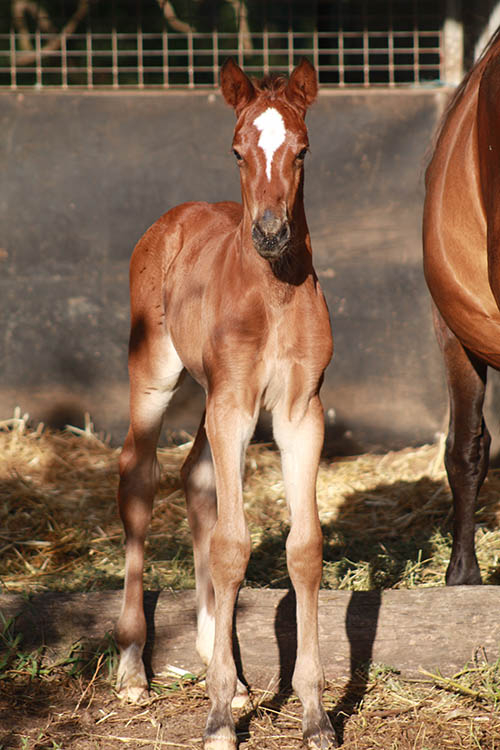
“Every horse has its own
special character.”
Take Diamond B Vivienne, a Vivant mare that Helen bred from embryo through foaling to breaking in, to baby classes and right the way through to Grand Prix. Having just started her career at the top end of the sport, she has won the highest classes at the Sydney Easter Show and more recently the Chatham Park Grand Prix at the Summer Classic in Sydney. This mare has simply followed the systematic and simplistic jumping training set down at Diamond B Farm.
Reading through the training scale set down by Helen and all her experience brings us on to producing the icing on the cake, when all goes well, to start the horse in Grand Prix. From horses like Vivant, Conquistador, Navy Seal, Stretch, Scandal and Ego, to mention some of the international horses Helen has been a part of producing, and now Diamond B Vivienne, yet another product of diligent training.
“The most important thing is that, as much as the training program has a strong core, it has to be somewhat flexible,” explains Helen. “Every horse has its own special character. They are not all the same. They are not all mentally similar and every horse that comes under our eye to train is taken as an individual and the agenda is adjusted accordingly.
“There is a strong underlying basis to the training,” she adds, “and if I had to say what that is, it is to go slowly and take no short cuts. Gain trust and confidence. Get a good flatwork understanding before contemplating the jump. You know their ability from the free jumping, and to enhance this you never can be in a hurry to jump bigger fences. To have an adjustable horse that can go forward and collect and stay straight and is forward thinking is of the utmost importance before any jumping. To have that adjustable control and a half-halt in the canter, to realise the horse can wait or go forward in a calm yet positive and sharp way, is imperative.
“We usually know the father, the mother and often the younger siblings now, so we have a real insight into what to expect. To be forewarned is to be a step ahead, and from the riding and schooling of all horses, and knowing the family traits, is a real advantage. So, to find out as much as you can about the bloodlines and the traits that they may throw at you, and how the siblings or similarly bred progeny react, is often an insight in to the long-term program.”
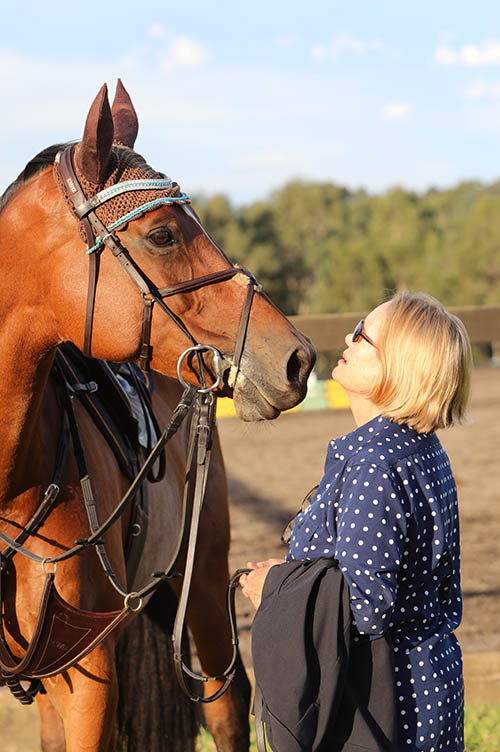
REALITY CHECK
Helen explains that once you know the horse’s character and their strong and not-so-strong attributes, you have a reality check and know where the training needs to be weighted! You simply need to focus on their weaker attributes and encourage these to be better. It is also really about the half-halt… a rebalancing exercise that is a feeling between the horse and rider that is pretty much unperceivable, yet reactive and positive.
“When our horses have come through the ranks from the young horse classes to the metre-plus classes and then reach Grand Prix, it’s really the calmer end of the wedge. Despite the pressures of this high-end competition, by this stage we know our horses and try to think of it as simply another round, not as a World Cup qualifier. The hard work is done and it’s a matter of continuing exactly the same but with quicker yet calm responses on the flat. The important thing is that, when a jumper gets on course his job is to look at the top rail and to clear it. With the training from the young horse onwards, there has never been a need to rush; there is not an adrenalin rush in any of the rounds nor training, and as a consequence the horses also learn a lot for themselves. They actually seem to have developed a confidence to look at the strides and analyse the fence, just as a good polo pony analyses the ball and knows where to position themselves through constant practice,” says Helen.
Of course, as Helen has said many times, there are some horses that just don’t have the heart and ability to make it to Grand Prix, and it’s unfair to push them until they can’t cope. It is important to keep then confident and happy by finding another sport for their talents. Some dressage horses can be champion Small Tour horses but never make it to Grand Prix. If you push them to do Grand Prix when they struggle, they don’t like to fail and you break their confidence. As a consequence, you won’t even have a Small Tour horse, and with jumping this is more so. You do need to know when the horse has found its level and only the top group of horses make it to 1.5m to 1.6m classes, as you need that special genetics and natural flare. Helen is always so aware of this, of when to push ahead and when to stop, and even when to decide the time has come for the good horse to settle with a new suitable owner where its talent and ability can be best used.
All this said and done, when it gets to the training of the seriously top-level horses, Helen’s attitude is unchanging from the early training principles. One thing that is super evident about her producing top horses is that she is acutely aware that the road to Grand Prix can be very tough and you need a sound horse – mentally and physically – at the age of 12 and onwards when they reach their higher competitive level. A lot of fences jumped, a lot of transitions and lateral work and a lot of leg work has gone on with horses’ joints and brains, and Helen is a stickler for attention to health and wellness. She uses physios and masseurs a lot to keep an eye on soundness and muscle activity and areas of stress; she is always checking correct saddle fitting; she is a perfectionist with shoeing and teeth; she leaves no stone unturned.
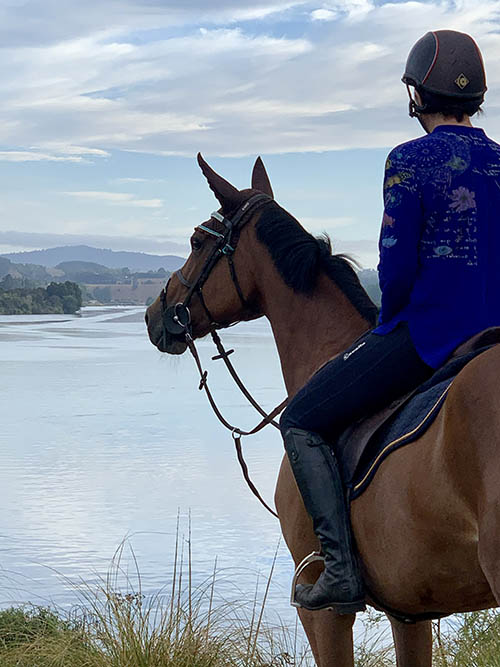
AN EYE FOR DETAIL
Not to mention that Helen plans all the feeding regimens (and mixes individual feeds daily) that are not constant but can vary, sometimes from day to day depending on such variables as a show coming up, a few big days’ work, a few days of no work, weather and so on. She hates to see horses getting too fat, especially when not in work, as with the emergence of many problems associated with sugars in horses’ diets she knows what is good and not so good. Having KER and Prydes as sponsors (and what better person to sponsor) she has the best of information as she is exceedingly well read and takes advice from the experts and appreciates their availability.
As can be seen, looking after and working with horses at the highest level needs attention to so many things, not just jumping big fences! Training at this level still involves many days of general work on improving smooth lines and control between fences – and so related distances are often practised and only over small fences. There are no big fences jumped or very, very rarely. The arenas at Diamond B are always well groomed, especially at landings and take-offs and a day never goes by without a serious grading. The sand jump arena is huge and well shaded by wonderful gum trees. The sand flatwork arena is also very spacious and well maintained and watered regularly.
There are areas to wander to and from around the work areas, but the horses, once at a higher level, do not go out on paddock rides or on the roads. Surfaces and joints are of the utmost importance. Riding in extreme weather conditions is avoided, especially windy days, as the last thing needed is anxiety and spookiness. One false leap or a distracted rail down can be disastrous.
Fitness is another area of attention and on some days when the work needs to be light but fresh, a walker is used. The walker is also used after a few days off to warm up the horse with no dramas. It’s safe and good for the mind and body. The walker is very wide diameter and goes in either direction and can be set at trot but usually to produce a purposeful walk.
Amanda has an amazing affinity with the horses as she has also been part of their lives since they were conceived! She is not only a talented rider and coach but also a hard worker around the stables. This work with the horses builds a huge bond and by the time they get to the big classes Amanda can tell you every little detail about what they have done from the beginning to the end of the day. She is very aware of any abnormal behaviour. This dedication and affinity on a daily basis makes for a very well rounded and competent and confident horse and rider combination.
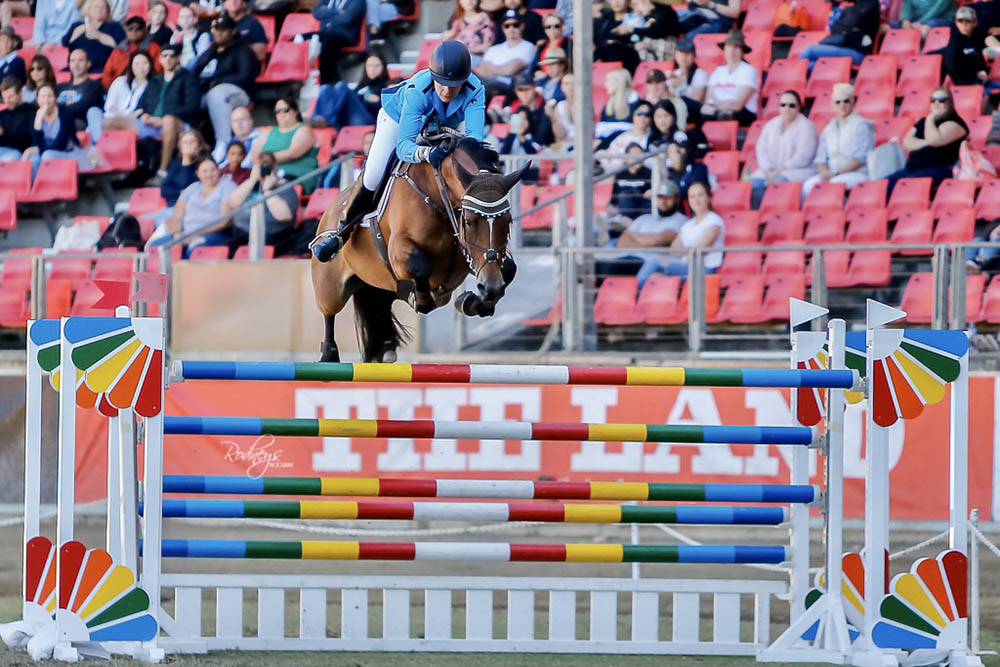
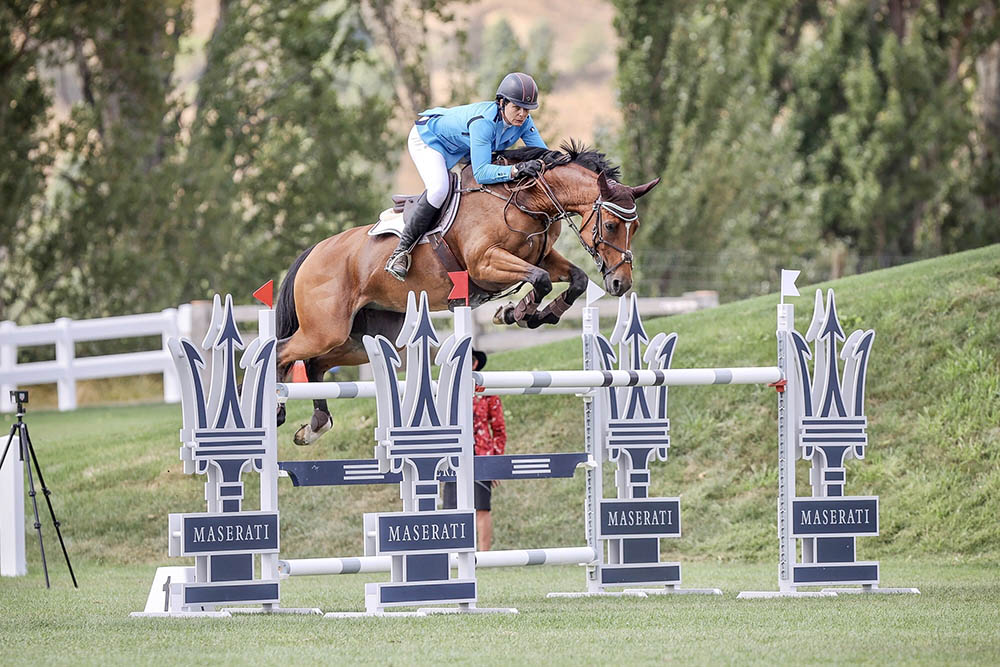
A ROUTINE FOR EACH HORSE
One of the obvious differences when you get to competing and training the higher-level horses is that you need to plan the days, sometimes weeks, ahead before a big class, and again this will vary from horse to horse and depends whether it’s a run of shows or single event. A routine has been sorted for each horse, for example work in the morning of the class; jumping so many days before; when to have an easy day and when to have a harder day. Make sure that the horse is super fit and mentally in the best place. It is really about learning and listening to your horse’s needs. It’s about the horse in the years of training that culminate in knowing what to do in the lead up. Hotter ones need maybe less energy feed, slower or longer work or even two short workouts for a few days, time on the walker and the list goes on.
There is also jumping fitness, and this is kept up with small fences and gymnastic jumping at regular intervals and the odd training day where they will go to a good jumping arena nearby or a training day and jump interesting lines and fences of height. Life as a competition, top-level horse needs to be kept as another day in the office. They need to also feel special and respected.
The day of competition is another article really and again Helen and Amanda discuss and know every detail and timing until they go in the ring. It’s not a chance thing, it’s not luck; it’s a superbly orchestrated routine that is seamless and non-fussed that only experience, good horses, top riding and passion can produce. It takes years in the making, after which they are not going to cut any corners.
PROVEN SUCCESS
The proof is in the pudding and yet again Diamond B Vivienne has proven the system. She is in her first 12 months at Grand Prix and has been amazingly successful. With Covid for two years, it has been frustrating yet these two have continued on with her training regardless with monotonous regularity to her wellbeing and it pays off. There have hardly been any shows but at every one she has turned heads. She was fourth at her first overseas Grand Prix at Takapoto in New Zealand at the end of 2020.
The longevity as well as the health and well-being of Diamond B’s horses are certainly a high priority:
- Vivant competed successfully internationally until 18.
- Diamond B Ego competed successfully until 17.
- Conquistador was still going at the highest level until 16.
- Diamond B Vigo was one of the first Vivant progeny and at the age of 18 is still very successful.
This is testimony to a successful and fabulous work ethic and training schedule of which Helen has been a lynchpin! There are horses from foals at every age in training and all happy healthy athletes at Diamond B. It is a system of logic and passion that works. Helen and Amanda know all about work, but they also believe you need to sow before you can reap. EQ
YOU MIGHT ALSO LIKE TO READ:
PART 2 – ‘How Diamond B Continues to Produce Gems’ (Equestrian Life, November, 2021)
PART 1 – ‘How Diamond B Produces Its Gems’ (Equestrian Life, September, 2021)
‘How Diamond B Became So Polished’ (Equestrian Life, November, 2020)

